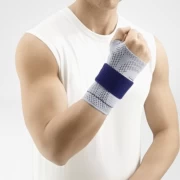
What are the Prosthetic Foot Types?
- What are the Prosthetic Foot Types?
- PROSTHETIC FEET TYPES
PROSTHETIC FEET TYPES
The prostheses applied for the stumps between the knee and ankle are called the Trans Tibial Prosthesis. The ideal stump length preferred for comfort in the use of the prosthesis is amputations (12cm-17cm) made from the middle 1/3 of the Tibia Bone. If the stump is longer or shorter, different alternative methods and different prostheses are used.
This type of prosthesis is needed if the leg is lost below the knee or at the knee level. For these prostheses, classical or vacuum systems with different properties are used.
For successful prosthesis application, it is recommended to use a temporary prosthesis after surgery. Walking and rehabilitation are more successful in amputees using temporary prostheses.
1) Temporary (intermis) Prosthesis Applications
Temporary prostheses are used as soon as the wound in the stump heals, and when the wound is closed 10-15 days after surgery, the preparatory line temporary prosthesis should be applied.
Temporary Prosthesis;
- It shapes the stump
Allows early walking
Individuals return to work early with positive motivation
Allows pre-assessment of problems in permanent prosthesis
It enables the user to adapt to the prosthesis.
Temporary prostheses are made of pressure-adjustable air cushion shafts or thermoplastic materials that can be shaped at low temperatures.
The service life of the permanent prosthesis, which is made to the stumps that become tight and shaped after bandaging and stockings and temporary prosthesis application, is longer.
Below-knee prostheses are diversified as "Modular" and "Classic". It is possible to manufacture both of them in different materials and colors.
The most important difference between them is weight, manufacturing technique, comfort of use and price.
2) Modular Knee Prosthesis
Prosthetic carrier parts are made of materials such as steel, aluminum, titanium or carbon, and are obtained by covering the tube (pipe) and modular adapters that adapt to the tube with a cosmetic coating.
Although modular prostheses are more expensive than conventional prostheses in the initial construction phase, they have many advantages.
It allows the prosthesis to be changed due to the easy disassembly and assembly of all modular parts, the possibility of adjustment, and the changes that occur in the stump over time. For this reason, it is both economical in the long term and the service life of the prosthesis is longer.
3) Types of Sockets Used in Knee Prosthesis
The prosthetic parts and the prosthetic foot are connected to the stump with a socket made of a hard material called a socket. Different techniques and materials are used to prevent the socket from separating from the stump and sticking to the body. With the development of technology, the methods of attaching the prosthesis to the stump are developing and changing.
In the KBM and PTB (suspension) attachment system, soft materials are used between the stump and the hard socket, and this is called soft socket. In addition to soft sockets, extra stump stockings are used when necessary to connect the prosthetic socket to the body. In recent years, stump suspension systems called Silicone Liner have become much more common. Silicone systems are especially recommended for patients with skin problems and diabetes.
4) Classic Knee Prosthesis
Aluminum, leather and polyester resins are used in this type of prosthesis. Since it is one piece, it does not allow for later adjustments and changes. Classical prostheses are not preferred as much as before due to developing technology and new prostheses.
In order to ensure the attachment of the prosthesis in short stumps, it is necessary to attach the prosthesis to the knee by various methods with the addition of the orthosis knee joint on its side.





